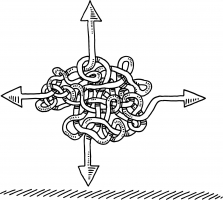Business in the post-lockdown era


As we write in late May 2020, lockdowns are slowly lifting across the regions most affected by COVID-19. Global news media are awash with content on every possible aspect of the process, from personal tragedies and local heroes all the way through to global economics and geopolitics. Many consumers have decided to regulate their consumption of news, just to stay sane.
In the business world too, executives are engaged in grueling rounds of back-to-back virtual meetings to work out how to cope with an unpalatable mix of urgent short-term issues for survival, medium-term priorities for recovery, and long-term strategies for regrowth. In this issue of Prism we have sought to provide some useful insight into the latter – what could the world look like in the next two to five years as we emerge into a new status quo after the immediate crisis, and what would this mean for businesses across different sectors?
We asked our experts in strategy, risk, banking, telecoms, petroleum, automotive, chemicals and pharma to give us their perspectives. These are all based on studies, data analysis and – most importantly – conversations and current work with clients on the frontline. While each sector has its own unique issues, most striking are some of the commonalities in the pictures they paint of the new post-lockdown world, for example:
- Uncertainty: The only thing certain about the new world is its uncertainty across multiple dimensions, and any claim to be able to forecast exactly how things will pan out is likely to be suspect. Scenario-based thinking will therefore be key for strategic decision-making.
- Disruption: The disruption from COVID-19 has been, and will continue to be, profound. However, in most cases the trends that we expect to see going forward already existed to a large extent, such as digitalization, responses to climate change and protectionism. The crisis seems to be giving them a turbo-boost.
- Economic recession: That we are facing the mother of all economic downturns is beyond doubt, and this is, of course, a major factor to address for business. However, the depth and duration of the downturn and the shape of the recovery curve are very much open to debate. How this ultimately turns out will make a big difference to strategies for business.
In this edition of Prism, we wanted to give our experts free reign to provide their perspectives without constraining them in terms of format or structure. We have, therefore, decided to present different versions of future-scenario models without trying to come up with a single, unified approach. In fact, we strongly believe there is more than one way to “cut the cake”, and that different approaches can be more suitable for different purposes without being contradictory.
We hope you enjoy the insight in this special edition of Prism, and look forward to working with many of you as we put our shoulders to the wheel and face up to the future!

Rick Eagar
Chief Editor, Prism
Arthur D.Little
DATE
July 2020

As we write in late May 2020, lockdowns are slowly lifting across the regions most affected by COVID-19. Global news media are awash with content on every possible aspect of the process, from personal tragedies and local heroes all the way through to global economics and geopolitics. Many consumers have decided to regulate their consumption of news, just to stay sane.
In the business world too, executives are engaged in grueling rounds of back-to-back virtual meetings to work out how to cope with an unpalatable mix of urgent short-term issues for survival, medium-term priorities for recovery, and long-term strategies for regrowth. In this issue of Prism we have sought to provide some useful insight into the latter – what could the world look like in the next two to five years as we emerge into a new status quo after the immediate crisis, and what would this mean for businesses across different sectors?
We asked our experts in strategy, risk, banking, telecoms, petroleum, automotive, chemicals and pharma to give us their perspectives. These are all based on studies, data analysis and – most importantly – conversations and current work with clients on the frontline. While each sector has its own unique issues, most striking are some of the commonalities in the pictures they paint of the new post-lockdown world, for example:
- Uncertainty: The only thing certain about the new world is its uncertainty across multiple dimensions, and any claim to be able to forecast exactly how things will pan out is likely to be suspect. Scenario-based thinking will therefore be key for strategic decision-making.
- Disruption: The disruption from COVID-19 has been, and will continue to be, profound. However, in most cases the trends that we expect to see going forward already existed to a large extent, such as digitalization, responses to climate change and protectionism. The crisis seems to be giving them a turbo-boost.
- Economic recession: That we are facing the mother of all economic downturns is beyond doubt, and this is, of course, a major factor to address for business. However, the depth and duration of the downturn and the shape of the recovery curve are very much open to debate. How this ultimately turns out will make a big difference to strategies for business.
In this edition of Prism, we wanted to give our experts free reign to provide their perspectives without constraining them in terms of format or structure. We have, therefore, decided to present different versions of future-scenario models without trying to come up with a single, unified approach. In fact, we strongly believe there is more than one way to “cut the cake”, and that different approaches can be more suitable for different purposes without being contradictory.
We hope you enjoy the insight in this special edition of Prism, and look forward to working with many of you as we put our shoulders to the wheel and face up to the future!

Rick Eagar
Chief Editor, Prism
Arthur D.Little
TABLE OF CONTENTS

Strategy: How to cope with the uncertainties of tomorrow’s new world
Planning for the future has never been more difficult given the unstable and uncertain global environment that businesses face at both a macro and micro level. Based on insights from client conversations and internal experts, we outline the range of potential scenarios organizations could face, along with guidance and best practice on making strategic decisions in tomorrow’s new world.

Risk: Strengthening business resilience after COVID-19
Despite that they had invested in comprehensive crisis management planning, the spread of COVID-19 found many companies ill-prepared, even though it was a known risk with extreme consequences and a reasonable likelihood of occurring. Looking at the evidence, the authors consider the underlying causes of this poor preparedness and set out the key elements of a new business resilience approach suitable for the post- COVID-19 world.

Financial services: Banking on change – Transformation or failure?
Prior to COVID-19, banking was already under pressure from technology-enabled disruption, greater regulation and an ultra-low-interest-rate environment. The pandemic accelerates these trends, increasing the need for transformative change. How can banks achieve this? This article outlines the three imperatives for banks moving forward – and the consequences if they fail to transform sufficiently rapidly. Before the advent of COVID-19, the banking industry was already under pressure from three trends – technology, regulation, and the macroeconomic environment:

Telecoms: Leveraging adversity to leapfrog into the future
The telecoms industry has been able to weather the COVID-19 storm better than many sectors, and has even increased its importance for communicating in a locked-down, socially distanced world. What will be the longer-term impacts for different parts of the sector? This article examines the current environment and explains how CXOs can prepare for the potential challenges and opportunities in a postcrisis world.

Automotive: Accelerating disruption through creative destruction
Thanks to the rise of electric vehicles, digital and new ownership models, the automotive market was already facing unprecedented disruption. As this article explains, the impact of COVID-19 on newcar sales accelerates the need for radical change – now is the time to turbocharge transformation efforts and seize opportunities to thrive in a post-ICE era.

Petroleum: Surviving in the post-COVID-19 era
The pandemic has created a perfect storm for the global petroleum industry, combining oversupply with a dramatic fall in demand – all at a time when ongoing requirements to decarbonize economies are gathering pace. We look at potential scenarios for the future, analyzing the impact on different market players over both the short and long term.

Chemicals: The old normal or the new normal?
Given its central position to the global economy, the chemical sector has felt the full force of COVID-19, though some players have suffered more than others. We analyze who the winners and losers currently are, and focus on the steps that all chemical companies need to take now to seize future opportunities – rethinking their purposes, promises and portfolios to drive future growth, value creation and resilience.

Pharma: Strategic realignment for a better future
Amid the search for effective COVID-19 treatments and vaccines, the pandemic will have long-term side effects for the global pharmaceutical industry. As our article explains, companies will need to focus on change in three areas (portfolio reprioritization, accelerated R&D and technology transformation) if they are to position themselves successfully for the future.


